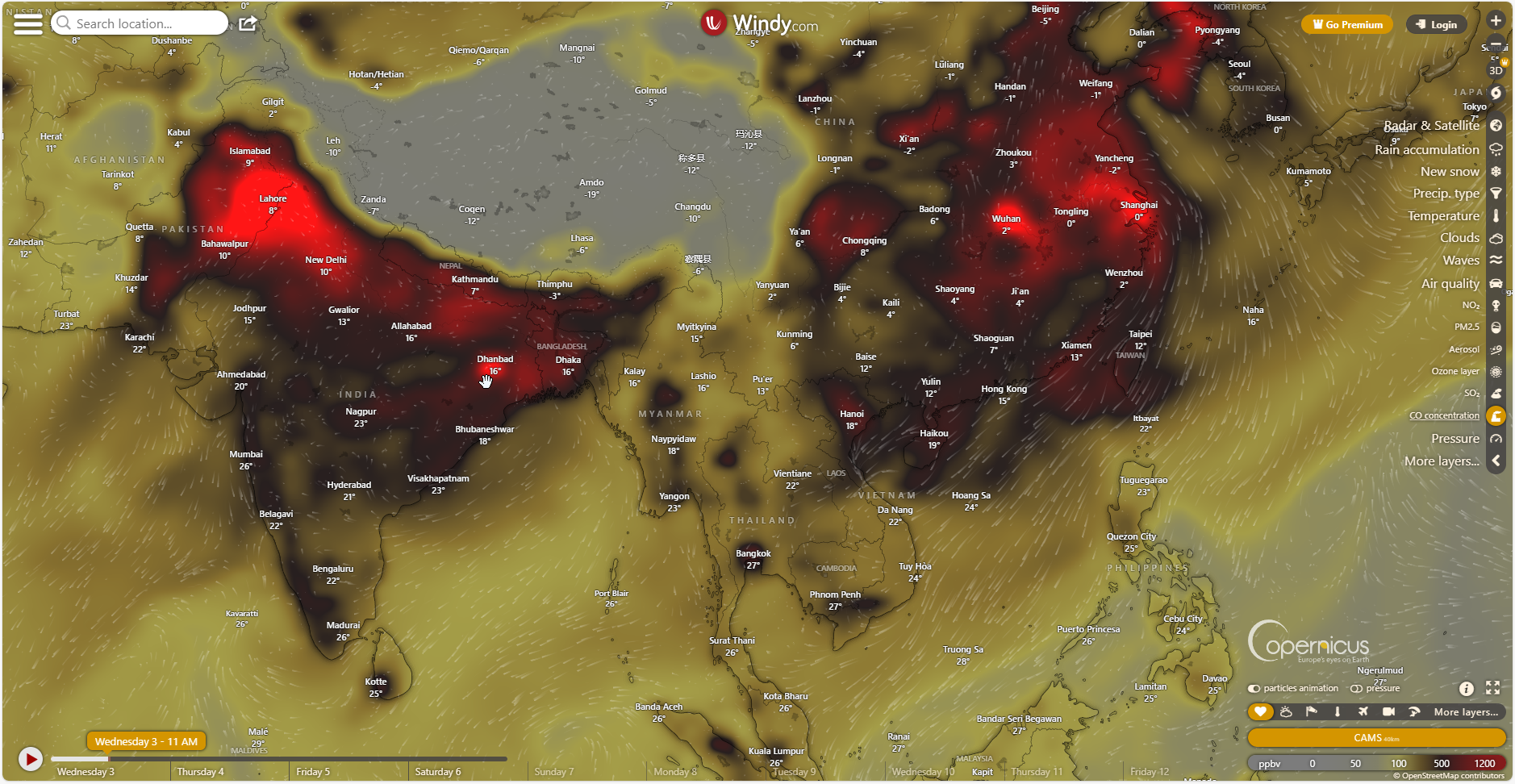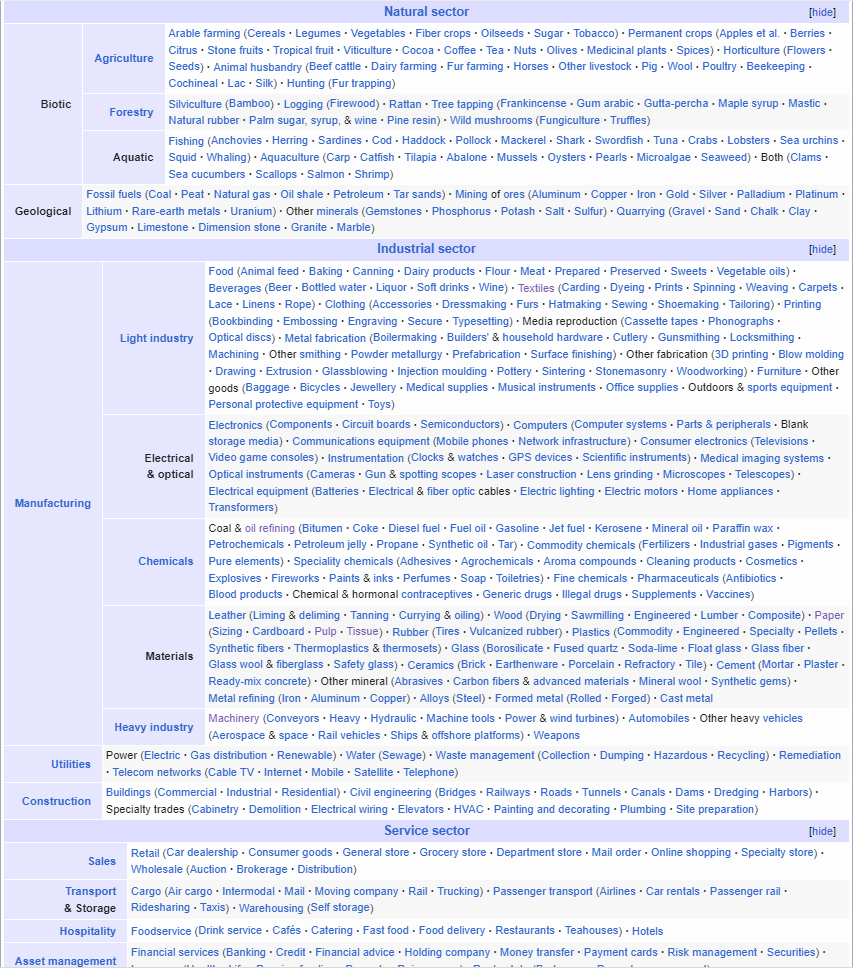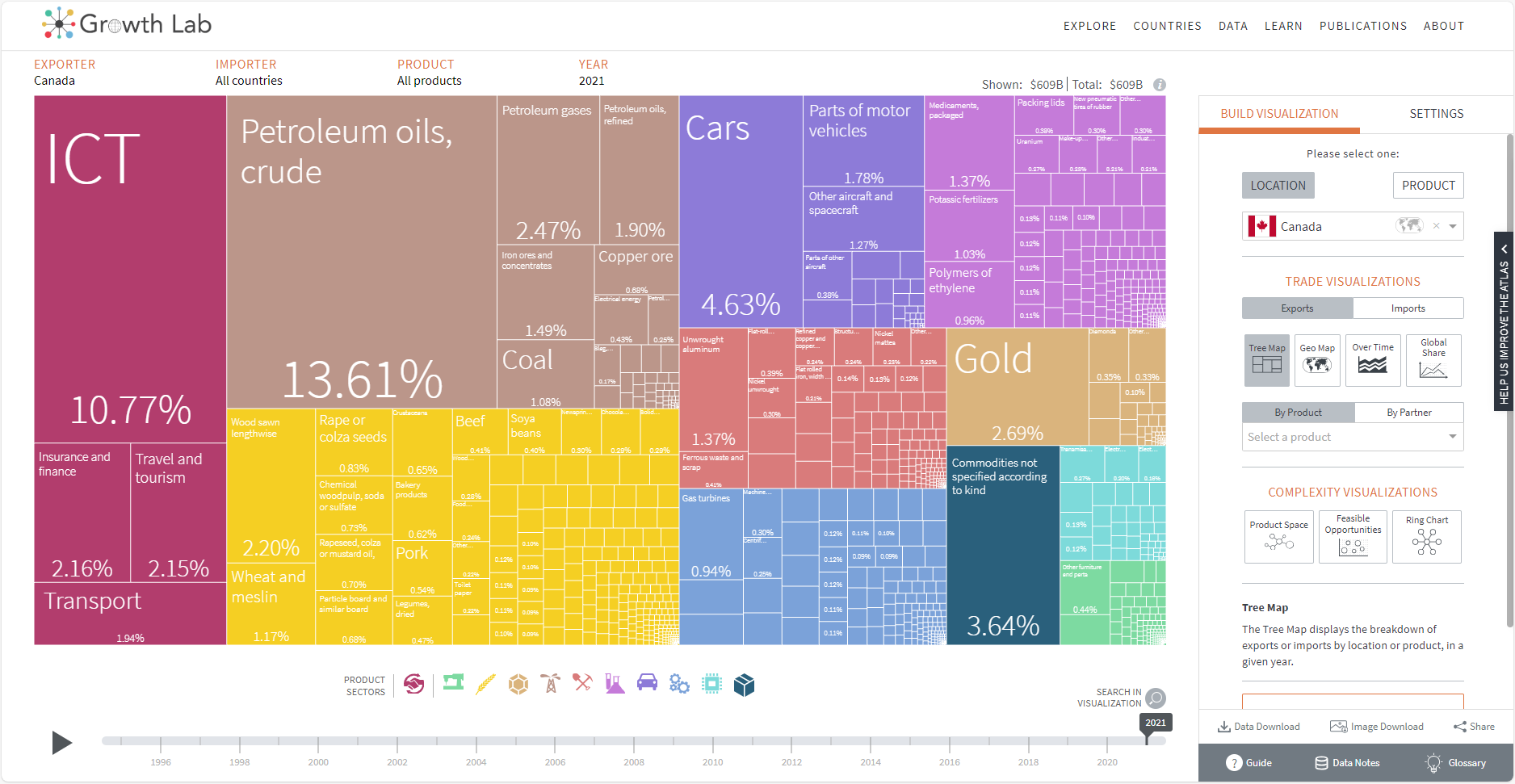INDUSTRY: A Global Overview
Aiming for the proverbial ten-thousand foot view both in terms of geography and categories.
Introduction
What do we mean when we talk about Industry? In this post (and others on the same theme that I have planned for this year), I'm using "Industry" in its narrower sense. So not an economic sector (e.g. the hospitality industry) but rather the transformation of raw materials to finished products (with the complexity of the modern economy there can be several stages of intermediate products). Such transformations require the input of energy—considerable amounts of thermal energy for many industries, especially the most fundamental ones—and the application of knowledge. Industry also implies large scale production and coordination of effort, in contrast to artisanal modes of production. Industrial facilities are commonly called plants, mills, factories, or works; these facilities represent large investments, generally have a large demand for labour, and often accrete a whole ecosystem of supporting services around them (crane rental businesses, welding contractors, commercial laboratories, stores selling PPE, hotels for travelling service technicians, etc.).
The View from the Back
One of the things I find very interesting about my job doing industrial wastewater treatment is the exposure it provides to a wide variety of industries. I'm seeing them from the back/effluent end as it were, but you can still learn a lot that way. Over the past ~dozen years I've visited plants from multiple industries (primarily but not exclusively in the Food or Ag-Processing sectors), and picked up some odds and ends about several others from working on proposals or reports.
Based on this experience, near the end of 2023 I thought it would be fun to make a series of #ELI5 / "How It's Made"-style videos with my oldest child showing how wastewater gets generated from a variety of production processes. She's still a toddler so there's parts she understood better than others, but I'll enjoy rewatching these videos with her and the rest of my family occasionally over the years as they ask questions about what I do for a living.
A lot of people associate industry with pollution. I'd contend that they are not inseparable companions. Certainly in my own field of wastewater treatment there has been great progress over the past several decades; Boston Harbor, for example, couldn't be the subject of a novel like Zodiac anymore. Improvements in air quality also shouldn't be taken for granted. The following screenshot from Windy.com shows carbon monoxide levels across much of Asia from earlier this month (similar trends are visible for NO2 and SO2 as well, but I went with CO since it was the most dramatic). The cursor is over the Dhanbad - Bokaro - Jamshedpur triangle in Jharkhand, India. This is not the worst area on the map, but it is a well-defined hotspot so I could figure out what's there. This area is a major centre of steel production in India, along with some other mining and heavy industry. By contrast, if you check air quality indicators across North America, no industrial clusters look anything close to this (sometimes forest fires do); I specifically checked Gary, Indiana (the largest integrated steel mill in North America) and Sarnia, Ontario (major hub of refineries and chemical plants) and their carbon monoxide levels don't stand out from other cities or the surrounding countryside. This goes to show that it is possible to responsibly treat or abate most emissions (water, air, noise) from industry.

The Categorical View
There are various ways to classify industries. This index template from Wikipedia is pretty decent. As noted in the previous paragraph, this post will focus on the Industrial sector; the Natural sector listed above is the source of the raw materials that get used and transformed in various ways.

The Light Industry category includes Food & Beverage production and packaging, Clothing and other textiles, Machining and other fabrication methods, among other things. There's another category for electrical, electronic, and optical devices, along with their components—intermediate products are very important in this category. The Chemical category includes things like the refining of fossil fuels, synthesis or purification of other important chemicals (e.g. fertilizers), and pharmaceuticals. The Materials category is quite broad ranging from wood products (lumber and pulp & paper), to plastics, to glass, to cement, and to metals. Heavy Industry mainly comprises machinery and vehicles in this categorization scheme on Wikipedia.
Some other categories or distinctions that I think are useful are:
- Industries that transform a raw material. Separation/purification processes like distillation are an important sub-category here.
- Industries that mix ingredients or reagents together to form a product, whether a blend (as in many food and beverage industries) or the output from some reaction (as in many chemical and pharmaceutical industries).
- Industries that mainly work on the shape or form of the material they're working with: molding, additive and subtractive manufacturing, forging, weaving, etc.
- Industries that assemble a finished product (or larger sub-component) from a discrete sub-components. There are many assembly steps to get to consumer electronics, machinery, and vehicles, for example.
There are also classification systems like NAICS and ISIC that are used for official statistics. But my aim here is to discuss the territory not the map.
The Geographical View
This section is based on an economic atlas that I shared in my last Links post. You can view the data on this site in so many different ways: by country, by product, on a map, on a time-series; the visualization and filtering tools are very good and I highly recommend playing around with it if this kind of stuff interests you at all. The data I'm using is from 2021 (the most recent year available at the time of writing). Some of the percentages mentioned might sound small at first, but keep in mind that 1% (or even less) is still a huge amount when considering total trade volumes in the hundreds of billions or even low trillions of dollars per year. I've selected the countries based on places I've been before (Germany was the shortest, with only an afternoon walking around Hamburg) but feel that this actually provides decent coverage.
Mostly I won't discuss the service sector, although this atlas does show it. It is in the lead for most countries discussed below. Note also that these statistics are all for exports (plus some discussion of imports in the case of Canada). Total production will be higher since some things are also made for domestic consumption, so what gets exported tends to be what a country has a competitive advantage in producing and is also conducive for shipping (services are actually quite challenging to export, for example, so the domestic service sector will certainly be bigger than what's shown in the charts I'm getting this data from).
I expect the entries below to be informative not only about where things are made (and where some raw materials are sourced) but also about what are some of the largest and most significant global industries (i.e. the ones that get mentioned really frequently).
The list starts with Canada and then goes in alphabetical order.
Canada: You can really see that natural resources are the strongest part of Canada's export economy. This includes minerals and metals, along with agricultural (which includes silviculture/forestry and fisheries/aquaculture in the way the data is presented here) products. Some are unprocessed (crude oil and mineral ores, for example) and others have had at least some processing (e.g. refined oil, sawn lumber, unwrought aluminum). The largest advanced manufacturing sector is automotive: adding up cars, motor vehicle parts, piston engines, commercial vehicles, and related categories gets over 7%. Finally, a few individual squares I thought were notable include: potash fertilizer (1%), crustaceans (0.65%), copper wire (0.3%), and peat and cement (0.1% each).

For Canada, I'll also discuss imports. The machinery sector (including computers at 1.6%) is notably larger than it is for exports. Chemical/pharmaceutical is a bit bigger. Textiles is not especially high in the import ranking, but it was dead last for exports. The cars/vehicles category is quite interesting as it is a very similar magnitude for imports and exports; this shows how integrated the North American auto-sector is, with vehicles in various stages of completion crossing the Ambassador Bridge (and hopefully the Gordie Howe bridge too next year) in both directions. The category 'Transmission apparatus for radio, telephone and TV' is where cellphones are counted so it is a prominent item for many countries and Canada's 1.7% is no exception.

Brazil: They are even more of a natural resources economy than Canada. As far as exports are concerned—I know they do have a lot of industry serving domestic consumption—a lot of the major products have minimal processing. Soya beans and iron ore both jump out (over 10% each), for example. Sugarcane (3%), coffee (1.7%), and meat (over 5% spread across a few kinds) are other major contributors. One well-known Brazilian company doing advanced manufacturing is Embraer and aircraft show up at 0.7%.
Denmark: Transport makes up 27% of Denmark's exports (with much of this due to the shipping giant Maersk). I haven't been discussing the service sector for other countries, but global shipping is very relevant to industrial supply chains, so I thought I'd mention this one. Denmark is also home to the pharmaceutical company Nova Nordisk that makes the weight loss drug Ozempic and the impact of this company shows up with 'packaged medicaments' being 5.8% of exports—and this has likely increased since 2021. In a small country like Denmark (not quite 6 million people), a couple of global-profile companies can make a huge difference. With Scandinavia being known for their furniture design it's fitting that seats and other furniture add up to over 1% of exports. Electrical generators and transformers also add up to over 1%. Apparently Denmark also has a large pork industry.
France: The pharmaceutical sector is large here. Agriculture is also very prominent for such an advanced economy; the largest contributor to that is wine, which does involve some processing. 'Aircraft and spacecraft' stand out at 3.6% (Airbus, based in Toulouse, is the notable company here); gas turbines at 1.4% presumably includes a lot of jet engines. France also exports a decent amount of energy, in the form of electricity (0.9%).
Germany: The two biggest non-service sectors of German exports are Machinery and Chemicals. Cars are big too, of course, at 6.8%. Both categories are pretty diverse, although the chemical category contains a strong pharmaceutical component. 'Machines not elsewhere classified' is at 1%, which really fits Germany's reputation of making the machines that make other machines; centrifuges alone are at 0.8% and even the very specific sub-category of 'machinery for the industrial preparation of food or drink' is over 0.1%.
Morocco: Morocco has a few categories of fertilizers accounting for over 14% of their exports. I'd heard before that they were one of the main places where phosphates are mined, so that makes sense. Fruits, vegetables, and seafood are other big exports for them. They have a relatively large textile sector compared to most of the other countries on this list. An interesting item is insulated electrical wire, with 3.2 billion in annual exports compared to 0.7 billion in annual imports of copper wire. This is a good example of globalized supply chains: bare wire gets made somewhere, gets bundled/insulated somewhere else, then exported again to be used (or incorporated into other intermediate products). I wasn't aware that they had an automotive industry, but apparently they export cars, too (I found after searching about this that Renault does some manufacturing there).
Netherlands: The Netherland's largest non-service export sector is chemicals (pharmaceuticals plus some industrial chemicals) with a diverse machinery sector close behind. This part looks quite a bit like the German economy. Agriculture is big in the Netherlands as well; cut flowers and live plants contribute 1.2%. They have a decent amount of North Sea oil and gas, too.
One notable example of a global chain of industries is cutting-edge semiconductor fabrication. A single company in the Netherlands (ASML) makes machines that can engrave circuits on silicon chips with extreme UV (EUV) light, achieving unprecedented precision. They get their optics from a single company in Germany (Zeiss) and a company in Taiwan (TSMC) have so far been the ones to use to its full potential (although if I understand correctly, Samsung and Intel are not far behind). This shows up in the global statistics: in 2021, "Apparatus and equipment for photographic laboratories, not elsewhere classified" (the category for photolithography) shows up as 4.46% of Taiwan's imports, 2.18% of South Korea's imports, and 1.84% of the Netherlands' exports.
Spain: Agriculture is their biggest non-service sector. Pork (Jamón ibérico presumably counting for a lot of this) at 1.25% is the largest, followed by citrus fruit (0.8%) and olive oil (0.7%). Aside from the fresh fruit, there'd be some processing involved. What surprised me looking at their chart was pharmaceuticals and cars being so prominent as I can't think of any specific Spanish companies making those off the top of my head.
UK: Their service sector comprises a large proportion of exports. After that, machinery is prominent; it looks pretty diverse with gas turbines (jet engines from Rolls-Royce being part of this, I presume) counting for 4.5%. Pharmaceuticals and other chemical industries are also a large contributor, along with cars at 6.3%. Liquor is at 1.65%—I expect a lot of this is whisky. Precious metals are also very prominent--over 10% between gold and platinum—but they show up in imports in similar quantities so my guess is that this represents activities like casting bars and minting bullion, or maybe it's just about providing a venue for the physical settlement of precious metal trades. The UK also has some North Sea oil and gas.
US: I'm not sure that a lot of people realize that the US is a net exporter of oil and gas now but these comprise over 8% of exports. They have large machinery and chemical/pharmaceutical sectors. Cars and integrated circuits are also significant exports at over 2% each. Notable agricultural exports include soya beans (1.1%) and corn (0.75%).
Yemen: Over half of their exports are crude oil, and the second highest category is scrap metal.
I've never been there, but you can't write about this topic without mentioning China. Electronics jump out as their largest export (smartphones, computers, etc.). 'Toys' is at 1.2% and 'other articles of plastic' is at 0.95%. Textiles are also a significant category. Their imports, by contrast, include a lot of raw materials or intermediate products. Iron ore, crude oil, and integrated circuits are all at 5% or higher. Even plastic inputs for manufacturing are significant: polymers of ethylene, styrene, and propylene add up to 1%. India is also informative to look at. They are much more diversified in their exports than their neighbours like Pakistan or Bangladesh, who mainly have textiles.
Additional Views
To wrap this up, here are some interesting factoids and links for further reading on this topic:
- The largest oil refinery in the world, Jamnagar in Gujarat, India, apparently has over 2,000 km of pipes (enough to span from the north to the south of India is how it was stated in the source I read). Densely packing linear features into a compact 2D or 3D space like this is something that shows up repeatedly in the means of production, from the largest factories to circuits etched on microchips.
- This Wikipedia article has 697 oil refineries listed in the world. That's a lot but not so many that it's infeasible to have a comprehensive list. Food processing plants are way more ubiquitous, and some other industries are much more specialized or niche, but for a lot of major industries, this is a pretty typical order of magnitude (~three digits) for the number of installations, which is relevant as the number of potential customers if you're making equipment that such facilities need.
- Reality has a lot of detail; almost every factory is unique in some way (even ones that were originally built as copies of each other will probably develop some differences over time in the course of maintenance and upgrades). Similarly, the statistics about exports necessarily group similar products together for reporting purposes, but the finer details matter to both producers and consumers.
- This site calls "understanding where our modern standard of living comes from" "industrial literacy". Check out their other essays and articles. I like the one about the history of iron and steel.
- The Chalcolithic and Bronze ages were a long time ago, but the demand for copper mining is greater than ever. (I have a book by the author of this article on my reading list for 2024).
- There are starting to be serious conversations in the United States about reviving the "arsenal of democracy" (I touched on this theme in my year in review post); Canada remains a lot more naive for now: "I expect that the light switch will indeed result in light and that the faucet in the bathroom will provide clean water. ... That makes sense: that has been the norm for us, for a long time."
- Led by SpaceX, the aerospace/rocketry industry is pushing the envelope again.
- Could turning vacant malls into hubs for industrial supply businesses, such as electronics components marketplaces, help promote industry in the surrounding area?
- Not having a high floor for competence in the workforce can make advanced manufacturing infeasible.
- An essay about the interaction between social organization and post-industrial society.